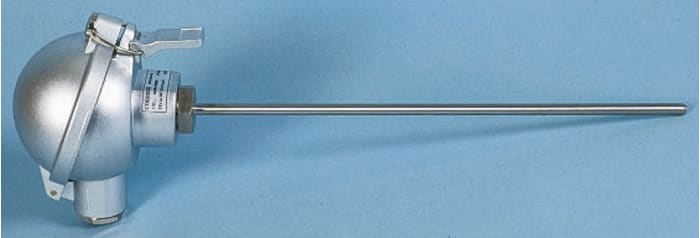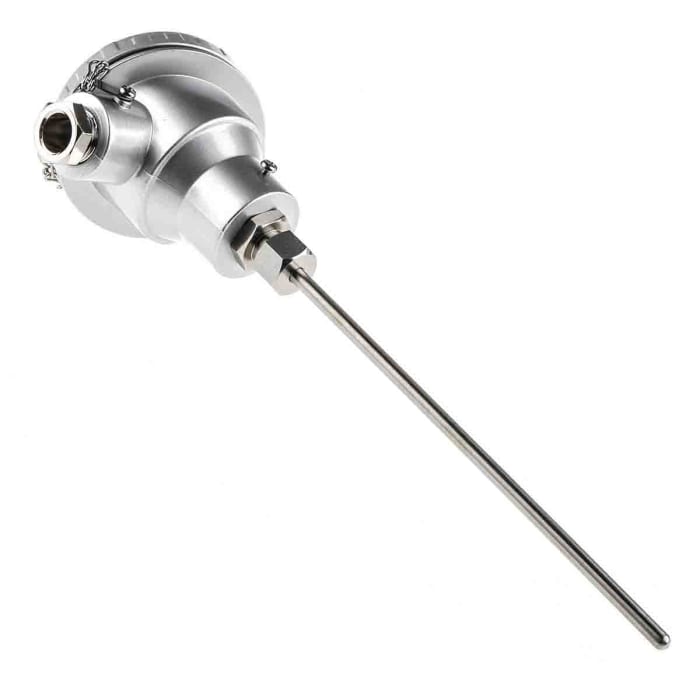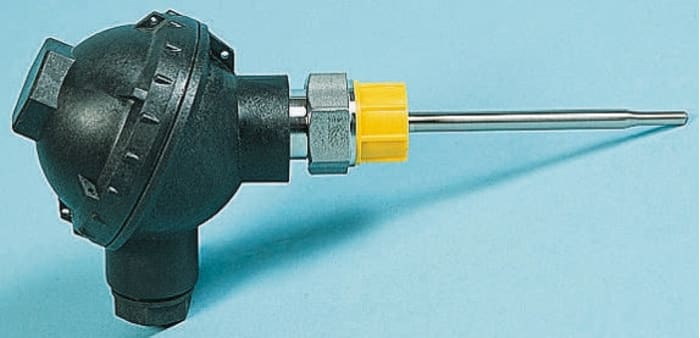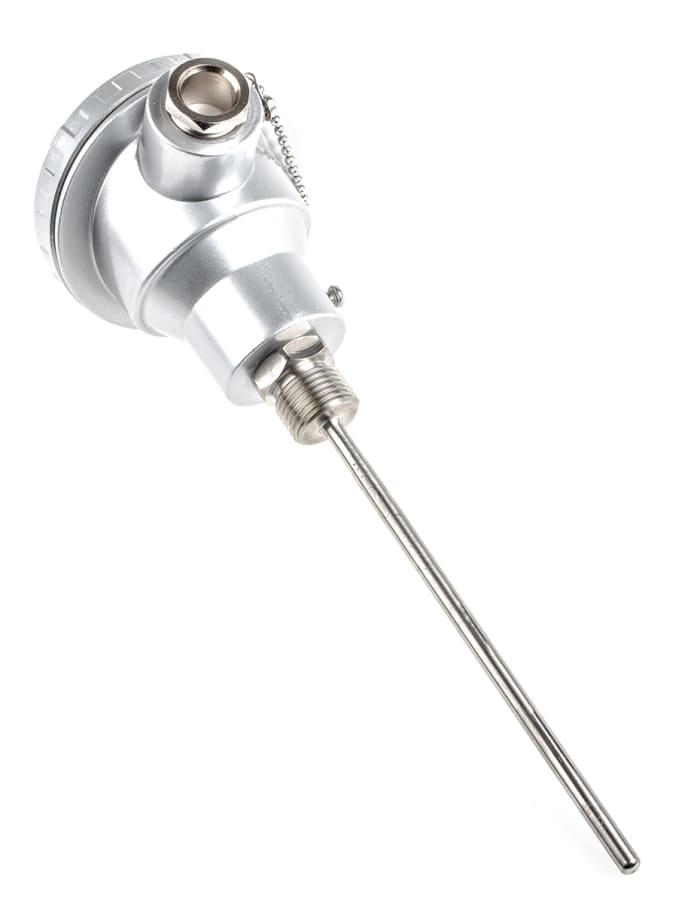Technical Document
Specifications
Brand
RS ProSensor Type
PT100
Probe Length
250mm
Probe Diameter
6mm
Minimum Temperature Sensed
-50°C
Maximum Temperature Sensed
+450°C
Termination Type
KNE Terminal Head
Probe Material
Stainless Steel
Process Connection
G1/2
Cable Entry Size
M20
Number Of Wires
4
Accuracy
Class B
Country of Origin
United Kingdom
Product details
RS Pro Heavy Duty 4 Wire Pt100 PRT Probe with Terminal Head
From RS Pro a high-quality heavy-duty Pt100 PRT (Platinum Resistance Thermometer) or RTD (Resistance Temperature Detector) sensing probe with a terminal head. This RTD probe has a robust construction with the sensing element encased in a rigid 6mm diameter 316 stainless steel sheath. The terminals of this Pt100 sensor are enclosed in an aluminium alloy terminal head which protects them against harsh environments. This heavy duty platinum resistance thermometer provides accurate and reliable temperature measurement for a wide range of applications.
What is an RTD?
An RTD is a type of temperature sensor based on the correlation between metals and temperature. As the temperature of a metal increases so does its resistance to the flow of electricity. This resistance can be measured and converted to a temperature reading. In a Pt100 RTD, the ’Pt’ stands for platinum (platinum wire or film) and ’100’ means that the temperature sensor has a resistance of 100 Ohms at 0°C. Platinum is the most reliable metal due to its linear resistance to temperature relationship over a large temperature range.
What is a Pt100 Probe with Terminal Head?
The Pt100 temperature sensor element is mounted inside a metal sheath or probe. This sheath protects the element from being damaged by the surrounding environment when it is inserted into the process to be measured. The probe lead wires are connected to a terminal block which is enclosed in a heavy duty terminal head which protects the connection against harsh environments. The terminal head has a cable entry allowing it to be connected to external measuring equipment and a screw cover to allow access to the connections.
Features and Benefits
• High stability sensing element with a precision output
• IEC 60751 Class B accuracy/tolerance
• Temperature measurement range of -100 to +450°C
• Rigid corrosion resistant 316 stainless steel sheath for protection of sensing element
• IP67 rated aluminium alloy weatherproof terminal head
• in” BSPP process connectio
• M20 x 1.5mm cable entry with gland for external connections
• 4 wire connection terminal block
• Screw lid with chain for easy access to connections
Applications
These heavy-duty PRT sensor probes with their robust design are ideal for use in many industrial applications including the following:
• Air conditioning and refrigeration
• Chemical industry
• Plastics processing
• Stoves and grills
• Air, gas and liquid temperature measurement
• Exhaust gas temperature measurement
• Food processing
• Laboratories
Frequently Asked Questions
How Does a PRT Temperature Sensor Work?
The PRT temperature sensor works by placing the sensor element (or process end) into the equipment or process that requires temperature measurement. As the temperature of the platinum resistance thermometer increases it’s resistance to the flow of electricity increases. For every increase per degree of temperature the electrical resistance also changes by a set ratio, this is called the temperature coefficient. For platinum, this ratio is .00385 ohm/ohm/°C which means for a Pt100 with a 100 ohm resistance the increase in resistance per degree of temperature would be 0.385 ohms. The total resistance reading can, therefore, be measured and converted into temperature.
How is the Resistance Measured?
The resistance generated by the temperature sensor is measured by passing current through one of the wires to produce a voltage. This voltage is then measured using a suitable bridge or voltmeter and the resistance calculated in ohms using Ohm’s Law (R=V/I). Once the resistance is known you can convert it to a temperature reading using a calibration equation or a Pt100 table. A temperature measurement device or calibrator can also be connected to the leads of the probe that will automatically convert the measured resistance into a temperature reading.
PT100 Probes with Industrial Terminal Heads

EGP 7,113.99
EGP 7,113.99 Each (ex VAT)
1
EGP 7,113.99
EGP 7,113.99 Each (ex VAT)
1
Stock information temporarily unavailable.
Please check again later.

Technical Document
Specifications
Brand
RS ProSensor Type
PT100
Probe Length
250mm
Probe Diameter
6mm
Minimum Temperature Sensed
-50°C
Maximum Temperature Sensed
+450°C
Termination Type
KNE Terminal Head
Probe Material
Stainless Steel
Process Connection
G1/2
Cable Entry Size
M20
Number Of Wires
4
Accuracy
Class B
Country of Origin
United Kingdom
Product details
RS Pro Heavy Duty 4 Wire Pt100 PRT Probe with Terminal Head
From RS Pro a high-quality heavy-duty Pt100 PRT (Platinum Resistance Thermometer) or RTD (Resistance Temperature Detector) sensing probe with a terminal head. This RTD probe has a robust construction with the sensing element encased in a rigid 6mm diameter 316 stainless steel sheath. The terminals of this Pt100 sensor are enclosed in an aluminium alloy terminal head which protects them against harsh environments. This heavy duty platinum resistance thermometer provides accurate and reliable temperature measurement for a wide range of applications.
What is an RTD?
An RTD is a type of temperature sensor based on the correlation between metals and temperature. As the temperature of a metal increases so does its resistance to the flow of electricity. This resistance can be measured and converted to a temperature reading. In a Pt100 RTD, the ’Pt’ stands for platinum (platinum wire or film) and ’100’ means that the temperature sensor has a resistance of 100 Ohms at 0°C. Platinum is the most reliable metal due to its linear resistance to temperature relationship over a large temperature range.
What is a Pt100 Probe with Terminal Head?
The Pt100 temperature sensor element is mounted inside a metal sheath or probe. This sheath protects the element from being damaged by the surrounding environment when it is inserted into the process to be measured. The probe lead wires are connected to a terminal block which is enclosed in a heavy duty terminal head which protects the connection against harsh environments. The terminal head has a cable entry allowing it to be connected to external measuring equipment and a screw cover to allow access to the connections.
Features and Benefits
• High stability sensing element with a precision output
• IEC 60751 Class B accuracy/tolerance
• Temperature measurement range of -100 to +450°C
• Rigid corrosion resistant 316 stainless steel sheath for protection of sensing element
• IP67 rated aluminium alloy weatherproof terminal head
• in” BSPP process connectio
• M20 x 1.5mm cable entry with gland for external connections
• 4 wire connection terminal block
• Screw lid with chain for easy access to connections
Applications
These heavy-duty PRT sensor probes with their robust design are ideal for use in many industrial applications including the following:
• Air conditioning and refrigeration
• Chemical industry
• Plastics processing
• Stoves and grills
• Air, gas and liquid temperature measurement
• Exhaust gas temperature measurement
• Food processing
• Laboratories
Frequently Asked Questions
How Does a PRT Temperature Sensor Work?
The PRT temperature sensor works by placing the sensor element (or process end) into the equipment or process that requires temperature measurement. As the temperature of the platinum resistance thermometer increases it’s resistance to the flow of electricity increases. For every increase per degree of temperature the electrical resistance also changes by a set ratio, this is called the temperature coefficient. For platinum, this ratio is .00385 ohm/ohm/°C which means for a Pt100 with a 100 ohm resistance the increase in resistance per degree of temperature would be 0.385 ohms. The total resistance reading can, therefore, be measured and converted into temperature.
How is the Resistance Measured?
The resistance generated by the temperature sensor is measured by passing current through one of the wires to produce a voltage. This voltage is then measured using a suitable bridge or voltmeter and the resistance calculated in ohms using Ohm’s Law (R=V/I). Once the resistance is known you can convert it to a temperature reading using a calibration equation or a Pt100 table. A temperature measurement device or calibrator can also be connected to the leads of the probe that will automatically convert the measured resistance into a temperature reading.
PT100 Probes with Industrial Terminal Heads




